The key of G major always seems to inspire Bach to write music of great radiance, joy, gentleness and technical display (the ‘Goldberg’ Variations and the fifth French Suite come immediately to mind). The Partita No 5 in G major is no exception. He opens in playful mood with a Praeambulum, the first four bars of which become a kind of ritornello. The necessary hand-crossing adds visual effect. The assimilation of rhythms in the lyrical Allemande (playing the dotted rhythms to coincide with the triplets) brings an extra touch of grace. Agility and lightness of touch are required in the Corrente—harmonically the simplest such dance in the set. Ornamentation is an integral part of the exquisite Sarabande. Unlike those of the French Suites, the Sarabandes of the Partitas are already very florid and seem to require few additions from the interpreter, but not in this case. The use of double-dotting gives the rhythm extra poise and expressivity. Upon first hearing, the next movement, Tempo di Minuetta, is confusing. Surely a minuet has three beats to a bar, not two. Bach combines the two to make a whimsical, delicate dance. The 3/8 swing of the Passepied reminds me of the fourth variation of the ‘Goldberg’, having the same rustic charm. If it were not for the difficulty of the final Gigue, this Partita would probably be performed more often, but here Bach really goes to town with a double fugue—perhaps the most technically challenging movement of the six Partitas.
from notes by Angela Hewitt © 1997
La tonalité de sol majeur semble toujours inspirer à Bach une musique d’éclat, de joie, de douceur et de déploiement technique (les Variations «Goldberg» et la cinquième Suite française viennent tout de suite à l’esprit). La Partita nº 5 en sol majeur ne fait pas exception. Elle débute sur un mode allègre, avec un praeambulum, dont les quatre premières mesures deviennent une sorte de ritournelle. Le nécessaire croisement des mains ajoute un effet visuel. L’assimilation des rythmes dans l’allemande lyrique (jouant les rythmes pointés pour coïncider avec les triolets) apporte une touche de grâce. La corrente—harmoniquement, la danse la plus simple de l’ensemble—requiert un toucher agile et léger. L’ornementation fait partie intégrante de l’exquise sarabande. Contrairement à celles des Suites françaises, les sarabandes des partitas sont déjà très fleuries et semblent nécessiter peu d’ajouts de l’interprète, sauf dans le cas présent, où l’usage du double point confère au rythme un poids et une expressivité supplémentaires. À la première écoute, le mouvement suivant, tempo di minuetta, est déroutant. Assurément, un menuet possède trois, et non deux, temps par mesure. Bach combine les deux pour donner une danse fantasque, délicate. Le rythme à 3/8 du passepied me rapelle la quatrième variation «Goldberg», au même charme rustique. N’était la difficulté de la gigue finale, cette partita serait probablement interprétée plus souvent, mais Bach s’enflamme véritablement avec une double fugue—peut-être le mouvement le plus éprouvant techniquement des six partitas.
extrait des notes rédigées par Angela Hewitt © 1997
Français: Hypérion
Die Tonart G-Dur scheint Bach stets zu Kompositionen von großer Ausstrahlung, Fröhlichkeit, Sanftheit und technischer Verzwickheit inspiriert zu haben (es fallen einem sofort die „Goldberg“-Variationen und die fünfte Französische Suite ein). Auch die Partita Nr. 5 in G-Dur macht hier keine Ausnahme. Sie beginnt mit einer verspielten Präambel, die in den ersten vier Takten eine ritornellähnliche Form annimmt. Die erforderlichen Handkreuzungen liefern einen visuellen Effekt. Die Angleichung der Rhythmen in der lyrischen Allemande (die punktierten Rhythmen fallen mit den Triolen zusammen) verleiht dem Ganzem zusätzliche Grazie. Flinkes und leichtes Spiel wird dann in der Courante gefordert, die harmonisch betrachtet den einfachsten Tanz ihrer Art in dieser Sechsergruppe darstellt. Ein wesentlicher Bestandteil der exquisiten Sarabande ist die Verzierung; im Gegensatz zu den Sarabanden der Französischen Suiten sind die der Partiten von vornherein reich verziert und bedürfen daher nur weniger Ergänzungen seitens des Interpreten. Doch dieser Fall liegt anders. Durch die doppelte Punktierung gewinnt der Rhythmus noch mehr an Würde und Ausdrucksstärke. Beim ersten Anhören erscheint der nächste Satz, Tempo di Minuetta, etwas verwirrend, denn ein Menuett zählt zweifelsohne drei Schläge pro Takt und nicht zwei. Bach verbindet die beiden jedoch zu einem seltsamen und feinen Tanz. Der 3/8-Takt des Passepied erinnert an die vierte „Goldberg“-Variation, die den gleichen rustikalen Charme hat. Wären die technischen Anforderungen der abschließenden Fuge nicht so hoch, würde sie sicherlich häufiger gespielt werden, doch hier hat sich der Meister mit einer Doppelfuge ordentlich ins Zeug gelegt, was diesen Satz vielleicht zum technisch schwierigsten Satz aus allen sechs Partiten macht.
aus dem Begleittext von Angela Hewitt © 1997
Deutsch: Manuela Hübner


 Bach: Angela Hewitt – The Bach Recordings
Bach: Angela Hewitt – The Bach Recordings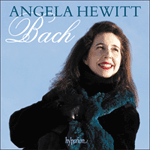 Bach: Angela Hewitt plays Bach
Bach: Angela Hewitt plays Bach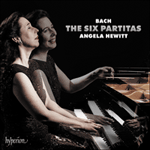 Bach: The Six Partitas
Bach: The Six Partitas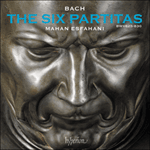 Bach: The Six Partitas
Bach: The Six Partitas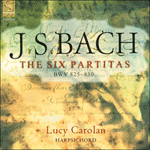 Bach: The Six Partitas
Bach: The Six Partitas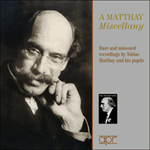 A Matthay Miscellany - Rare and unissued recordings by Tobias Matthay and his pupils
A Matthay Miscellany - Rare and unissued recordings by Tobias Matthay and his pupils
